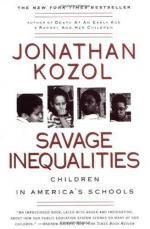
|
| Name: _________________________ | Period: ___________________ |
This test consists of 15 multiple choice questions and 5 short answer questions.
Multiple Choice Questions
1. The history of East St. Louis shows that African Americans were lured to the city for what reason?
(a) Low taxes.
(b) The promise of jobs.
(c) New housing.
(d) Good schools.
2. In the chapter entitled "Life on the Mississippi," what office is described as the largest office in Illinois?
(a) The Unemployment Office.
(b) The Welfare Office.
(c) The Lottery Office.
(d) Health Services.
3. Who was two hours late when they came to speak at East St. Louis High?
(a) Colin Powell.
(b) Martin Luther King, Jr.
(c) Jesse Jackson.
(d) Ron Brown.
4. Who authored the poem that one of the most embittered students in Kozol's class memorized?
(a) Robert Frost.
(b) Claude McKay.
(c) T.S. Eliot.
(d) Langston Hughes.
5. What statistic does Kozol give for the number of births in East St. Louis to single mothers?
(a) Three of five births are to single mothers.
(b) One of five births are to single mothers.
(c) Four of five births are to single mothers.
(d) Two of five births are to single mothers.
6. What Supreme Court decision found that segregated education was unconstitutional because it was "inherently unequal"?
(a) Davis, et. al. v. County School Board of Prince Edward County, VA et al.
(b) Briggs, et. al. v. Elliott, et. al.
(c) Plessy v. Ferguson.
(d) Brown v. Board of Education.
7. According to Carla Hawkins, Chicago's public schools are in short supply of what type of resource?
(a) Students.
(b) Teachers.
(c) Funding .
(d) Supplies.
8. What are the two sources of lead in East St. Louis named in the Life on the Mississippi chapter?
(a) Manufacturing and drinking water.
(b) Lead-based paint and lack of waste removal.
(c) Lead-based paint and manufacturing.
(d) Drinking water and lead-based paint.
9. What was the poem that is memorized by the students in Kozol's class about?
(a) Broken dreams.
(b) The public school system.
(c) Ghetto life.
(d) Infant mortality.
10. What is the name of the Villa Griffin child whose sister was murdered by a friend of the mother?
(a) Serena.
(b) Smokey.
(c) Little Sister.
(d) Mickey.
11. According to Kozol, when visiting urban public schools who refused to take him to the neighborhoods were the schools were located?
(a) Parents.
(b) School Administrators.
(c) Public Transit.
(d) Taxi Drivers.
12. In what year was the ruling in Brown v. Board of Education made?
(a) 1950.
(b) 1956.
(c) 1954.
(d) 1952.
13. How many years did Kozol spend visiting schools and speaking with children about their schools and neighborhoods?
(a) 3.
(b) 1.
(c) 2.
(d) 4.
14. What is the population of the town of Sauget?
(a) 200.
(b) 175.
(c) 150.
(d) 100.
15. At Mary McLeod Bethune School, what does the gospel teacher accuse the children of doing if they fail to sing properly?
(a) Not practicing the songs at home.
(b) Not loving the Lord.
(c) Not liking the gospel teacher.
(d) Not studying the music.
Short Answer Questions
1. According to Kozol, East St. Louis has one of the highest rates of which disease in America?
2. What types of schools does the Chicago public school system lack?
3. What year did Kozol begin teaching in Boston?
4. Approximately how many neighborhoods did Kozol visit?
5. How does the Post-Dispatch describe East St. Louis, Illinois?
|
This section contains 493 words (approx. 2 pages at 300 words per page) |

|




